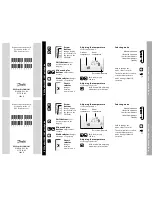
163
Determining the Error from the Current Situation for Temperature Measurement Errors
Section 7-5
7-5
Determining the Error from the Current Situation for
Temperature Measurement Errors
Error in Measured Temperature or Temperature Cannot Be Measured
Easy Method for Checking Thermometers
Platinum resistance thermometers: 1. Connect a 100
Ω
resistor between thermometer input terminals A and B
and short B and B.
2. The EJ1G is working if the measured temperature is 0.0
°
C or 32.0
°
F.
Thermocouples:
1. Short the thermometer input terminals.
2. The EJ1G is working normally if the temperature in the vicinity of the ter-
minal block is measured.
Possible cause
Countermeasure
Connection The thermometer polarity or connected terminals are wrong. • Rewire correctly.
A thermometer that cannot be used with the EJ1G has been
connected.
• Change to a compatible thermometer.
The thermometer has burnt out, short-circuited, or deterio-
rated.
• Replace with a better quality thermometer.
No thermometer is connected.
• Connect a thermometer.
A compensating conductor applicable to the thermocouple
has not been used.
• Directly connect a thermocouple with a long lead.
• Use an applicable compensating conductor.
A device using metal other than a thermocouple or compen-
sating conductor has been connected between the thermo-
couple and EJ1G terminals.
• Connect a device specifically for thermocouples.
The connection terminal screws are loose and the connec-
tion is imperfect.
• Tighten the screws securely.
The thermocouple lead or compensating conductor is too
long and is affected by the conductor resistance.
• Use a thicker compensating conductor.
• Change the wiring location and shorten the wires.
The resistance of the 3 conductors between the thermome-
ter and the EJ1G terminals is different.
• Use conductors with the same resistance for all three ter-
minals, A, B, and B terminals.
Installation
Affected by noise emitted by devices near the EJ1G.
• Move the EJ1G away from devices emitting noise.
• Connect a surge suppressor or noise filter to devices emit-
ting noise.
The thermometer lead is too close to the power line and is
receiving induction noise from the power line.
• Separate the thermometer lead from the power line.
• Run the thermometer lead through a different pipe or duct
from the power line.
• Do not wire the thermometer lead and the power line in
parallel.
• Wire a shorter thermometer lead.
• Use a shield on the thermometer lead.
The thermal response is slow because the installation posi-
tion of the thermometer is too far from the control point.
• Install the thermometer with the end of the protective tube
closer to the control point.
The ambient temperature of the EJ1G exceeds the rating.
• Keep the ambient temperature between the rating range of
−
10 to 55
°
C.
A wireless device is used in the vicinity of the EJ1G.
• Shield the EJ1G.
The terminal block temperature is inconsistent due to heat
radiated from peripheral devices.
• Move the EJ1G to a position where it will not be exposed to
heat.
An air current or draft is striking the EJ1G terminal block.
• Do not let air currents or drafts strike the terminal block.
Settings
The input type settings are incorrect.
• Correct the input type settings.
The temperature unit settings are incorrect.
• Correct the temperature unit settings.
The measured temperature seems incorrect due to the input
compensation setting.
• Set the input compensation to 0.0.
Procedure
The input terminals for a thermocouple input are shorted.
• Connect a thermocouple.
The thermometer was changed or the switch settings
changed while power was ON.
• Cycle the power.
Summary of Contents for EJ1G
Page 3: ...iv ...
Page 17: ...xviii ...
Page 21: ...xxii ...
Page 53: ...32 Unit Configuration Examples Section 2 4 ...
Page 69: ...48 Changing SPs During Operation Section 3 3 ...
Page 81: ...60 Other Functions Section 4 5 ...
Page 145: ...124 Other HFU Functions Section 5 7 ...
Page 167: ...146 Detailed Description of Services Section 6 4 ...
Page 229: ...208 Parameters That Can Be Allocated for Programless Communications Appendix ...
Page 237: ......
















































